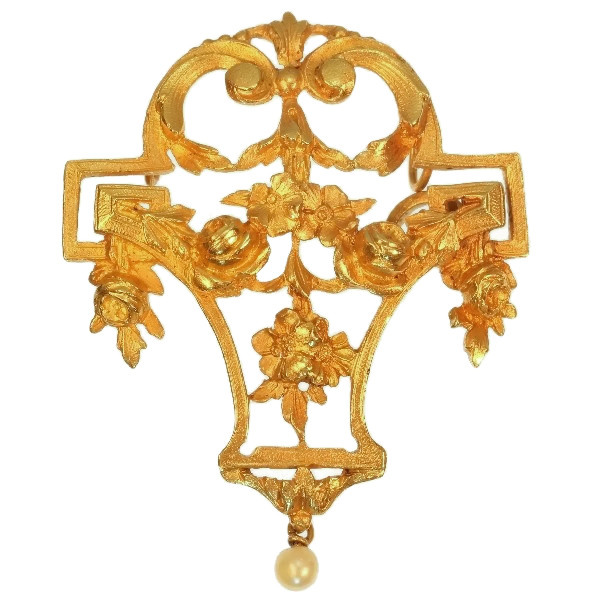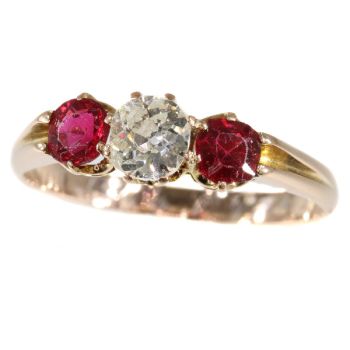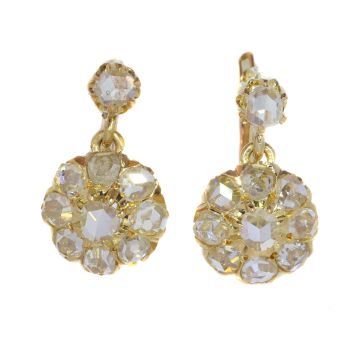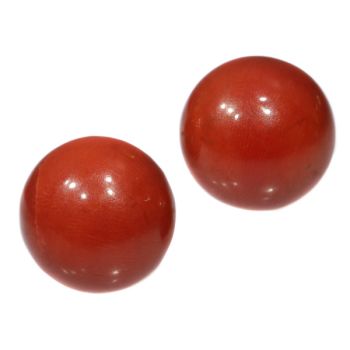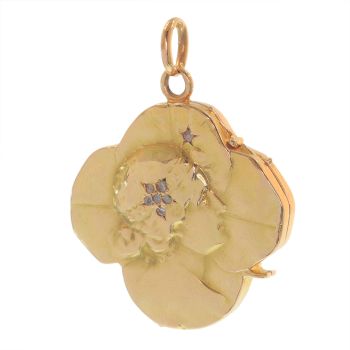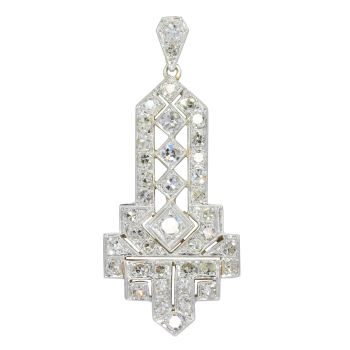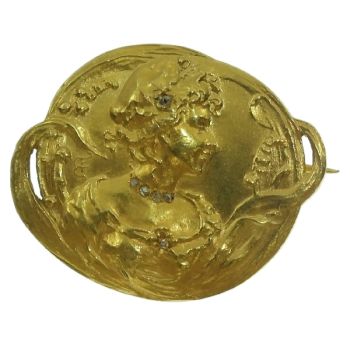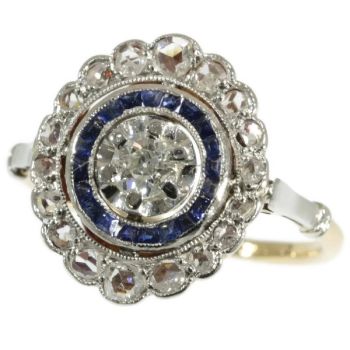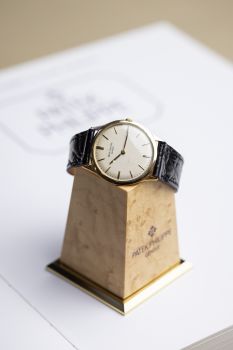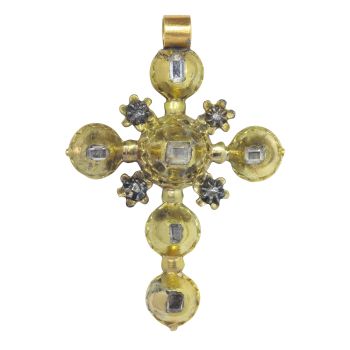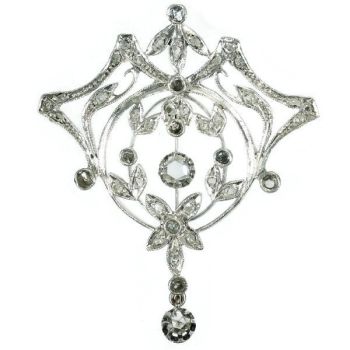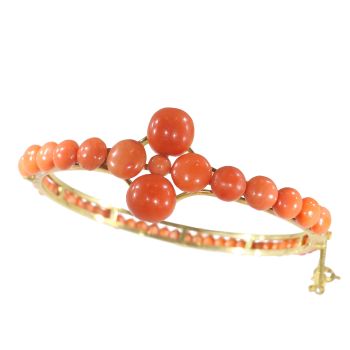French gold brooch pendant Late Victorian Belle Epoque Style Guirlande 1880
Unknown artist
Gold
€ 2.350
Adin Fine Antique Jewellery
- About the artwork
Antique jewelry object group: combined brooch-pendant
Condition: excellent condition
- (more info on our condition scale)
Country of origin: France
Style: Belle Époque - The Belle Époque (French for "Beautiful Era") was a period in European social history that began during the late 19th century and lasted until World War I. Occurring during the time of the French Third Republic and theGerman Empire, the "Belle Époque" was named in retrospect, when it began to be considered a "golden age" the major powers of Europe, new technologies improved lives and the commercial arts adapted Renaissance and eighteenth-century styles tomodern forms. In the newly rich United States, emerging from the Panic of 1873, the comparable epoch was dubbed the Gilded Age. In the United Kingdom, this epoch overlaps the end of what is called the Victorian Era there and the period named theEdwardian Era. or more info on styles
Style specifics: The Belle Époque (French for "Beautiful Era") was a period in European social history that began during the late 19th century from the Franco-Prussian War (1870-1871) and lasted until World War I (1914-18).
Occurring during the time of the French Third Republic and the German Empire, the "Belle Époque" was named in retrospect, when it began to be considered a "golden age" the major powers of Europe, new technologies improved lives and the commercialarts adapted Renaissance and eighteenth-century styles to modern forms.
In the newly rich United States, emerging from the Panic of 1873, the comparable epoch was dubbed the Gilded Age. In the United Kingdom, this epoch overlaps the end of what is called the Victorian Era there and the period named the Edwardian Era.
In the Belle Époque cheap coal and cheap labour contributed to the cult of the orchid and made possible the perfection of fruits grown under glass, as the apparatus of state dinners extended to the upper classes; champagne was perfected during the Belle Époque. Exotic feathers and furs were more prominently featured in fashion than ever before, as haute couture was invented in Paris, the centre of the Belle Époque, where fashion began to move in a yearly cycle; in Paris restaurantssuch as Maxim's achieved a new splendour and cachet as places for the rich to parade, and the Opéra Garnier devoted enormous spaces to staircases as similar show places.
After mid-century, railways linked all the major cities of Europe to spa towns like Biarritz and Deauville; their carriages were rigorously divided into first-class and second-class, but the super-rich now began to commission private railway coaches, asexclusivity was a hallmark of opulent luxury. Bohemian lifestyles gained a different glamour, pursued in the cabarets of Montmartre.
Period: ca. 1880
- (events & facts of this era, poetry of this era, fashion of this era)
Source of inspiration: Mother Nature (see also: flower symbolism)
Theme: The Rose - First of all a symbol of love but there are many prophecies, legends and fairy tales made about this beautiful flower.
A rose that blooms in autumn can mean a marriage. And you must remember the fairy tail of Sleeping Beauty. The bad queen pricked the beautiful, young princess with a thorn from a rose. She slept 100 years and a beautiful, young prince woke her up with akiss. They married and they lived happily ever after. There exists a legend about how the rose got her thorns. The rose grew originally in the Garden of Eden and had no thorns. After the fall the rose got her thorns to remind people of their sin. Herbeauty might been kept as memory of Paradise.
In the antiquity Eros, the Greek God of Love, was represented as a fresh and rosy (color of roses), lively and cheerful boy with goldish hair (like the stamens). The arrows were like the thorns and his wings were like the petals of the rose. In beauty,shape and scent, the rose is outstanding and hence has become the most commonly used floral symbol in the West. Roses have symbolical meanings in classic and Christian art. For example Venus was associated with roses, symbolizing love and beauty, whereas Virgin Mary sometimes was called a « rose without thorns » because of her purity.
Material: 18K yellow gold
- (more info on precious metals)
Precious stones: Onenatural seed pearl
Birthstones: Pearl is the birthstone (or month stone) for June.
- (more info on birthstones)
Hallmarks: The French control mark for 18K gold representing an eagle's head that was in use in France from about 1838.
- (more info on hallmarks)
Dimensions: 4,29 cm (1,69 inch) x 3,38 cm (1,33 inch)
Weight: 8,90 gram (5,72 dwt)
Reference Nº: 16333-0027
Copyright photography: Adin, fine antique jewelry
- About the artist
It might happen that an artist or maker is unknown.
Some works are not to be determined by whom it is made or it is made by (a group of) craftsmen. Examples are statues from the Ancient Time, furniture, mirroirs, or signatures that are not clear or readible but as well some works are not signed at all.
As well you can find the following description:
•“Attributed to ….” In their opinion probably a work by the artist, at least in part
•“Studio of ….” or “Workshop of” In their opinion a work executed in the studio or workshop of the artist, possibly under his supervision
•“Circle of ….” In their opinion a work of the period of the artist showing his influence, closely associated with the artist but not necessarily his pupil
•“Style of ….” or “Follower of ….” In their opinion a work executed in the artist’s style but not necessarily by a pupil; may be contemporary or nearly contemporary
•“Manner of ….” In their opinion a work in the style of the artist but of a later date
•“After ….” In their opinion a copy (of any date) of a work of the artist
•“Signed…”, “Dated….” or “Inscribed” In their opinion the work has been signed/dated/inscribed by the artist. The addition of a question mark indicates an element of doubt
•"With signature ….”, “With date ….”, “With inscription….” or “Bears signature/date/inscription” in their opinion the signature/ date/ inscription has been added by someone other than the artist
Are you interested in buying this artwork?
Artwork details
Related artworks
- 1 - 4 / 12
- 1 - 4 / 24
- 1 - 4 / 24
Samuel Dejong
Anatomia Blue Heritage, Hercules Open2017 - 2019
Price on requestVilla del Arte Galleries
 Curated by
Curated byGallerease Magazine
1 - 4 / 24- 1 - 4 / 12

